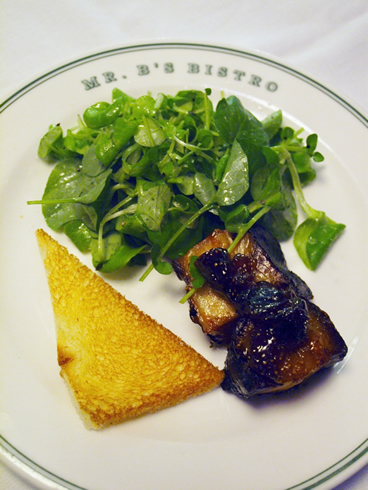[dropcap1]Q. [/dropcap1]About ten years ago I saw braised pork belly on the menu at Herbsaint. The waiter seemed to be really excited about it, so I tried it. What I got was a piece of gelatinous fat with a little bit of lean through it. I can't say it was bad, but there were too many things going on that I found unappetizing that I never ordered it again. It seemed like just a big block of fat. Now I see it on menus everywhere I go. What is it, exactly, and why should I like it? And one more thing. I remember seeing a column of quotations in the newspaper financial pages and for "pork belly futures." What is the future of pork bellies?
[caption id="attachment_26409" align="alignright" width="368"] Braised pork belly from Mr. B's, one of the best versions.[/caption][dropcap1]A. [/dropcap1]One answer suffices for both your major questions. The belly is the part of a pig--the underside, as suggested by the name "belly"--from which bacon comes. If you look at a strip of traditional breakfast bacon, and imagine that it's cut from a much larger slab of meat, you just about have it. The big difference between pork belly and bacon is that bacon is cured and smoked, while pork belly usually arrives at the restaurant raw.
Because of current American tastes, most bacon is much leaner than it once was. But even on lean pigs there are parts of the belly with a higher proportion of fat. Bellies from heirloom pig varieties--Berkshire, to name one--have a much higher fat percentage.
I don't know who in America triggered the trend of low-and-slow braising of the fattier slabs of pork belly instead of frying it. The technique always has been common in France and Germany. It turns out a piece of soft, uncrisped meat from which more fat is rendered off than if the same chunk had been fried.
Chef Donald Link, the owner of Herbsaint, was the first to serve braised Berkshire pork belly in New Orleans. The meat wholesaler who sold it to him no doubt encouraged other chefs to try it, and now the bellies are widespread, used as a menu statement of gourmet cooking. I'm not nuts about it, myself, although I have had enough really good versions that I consider it if I think the situation is right.
Pork belly futures were a sideshow at the Chicago Mercantile Exchange for many decades. It involved the same cut of hog, almost all of it destined to become bacon. Traders--most of them members of a closed, good-old-boy club-- strategized the buying and selling of frozen bellies, making and losing fortunes as the prices went up and down. The future of investing in pork bellies ended in 2011. You may now delete that memory.
Braised pork belly from Mr. B's, one of the best versions.[/caption][dropcap1]A. [/dropcap1]One answer suffices for both your major questions. The belly is the part of a pig--the underside, as suggested by the name "belly"--from which bacon comes. If you look at a strip of traditional breakfast bacon, and imagine that it's cut from a much larger slab of meat, you just about have it. The big difference between pork belly and bacon is that bacon is cured and smoked, while pork belly usually arrives at the restaurant raw.
Because of current American tastes, most bacon is much leaner than it once was. But even on lean pigs there are parts of the belly with a higher proportion of fat. Bellies from heirloom pig varieties--Berkshire, to name one--have a much higher fat percentage.
I don't know who in America triggered the trend of low-and-slow braising of the fattier slabs of pork belly instead of frying it. The technique always has been common in France and Germany. It turns out a piece of soft, uncrisped meat from which more fat is rendered off than if the same chunk had been fried.
Chef Donald Link, the owner of Herbsaint, was the first to serve braised Berkshire pork belly in New Orleans. The meat wholesaler who sold it to him no doubt encouraged other chefs to try it, and now the bellies are widespread, used as a menu statement of gourmet cooking. I'm not nuts about it, myself, although I have had enough really good versions that I consider it if I think the situation is right.
Pork belly futures were a sideshow at the Chicago Mercantile Exchange for many decades. It involved the same cut of hog, almost all of it destined to become bacon. Traders--most of them members of a closed, good-old-boy club-- strategized the buying and selling of frozen bellies, making and losing fortunes as the prices went up and down. The future of investing in pork bellies ended in 2011. You may now delete that memory.
Written by Tom Fitzmorris September 30, 2014 10:01 in